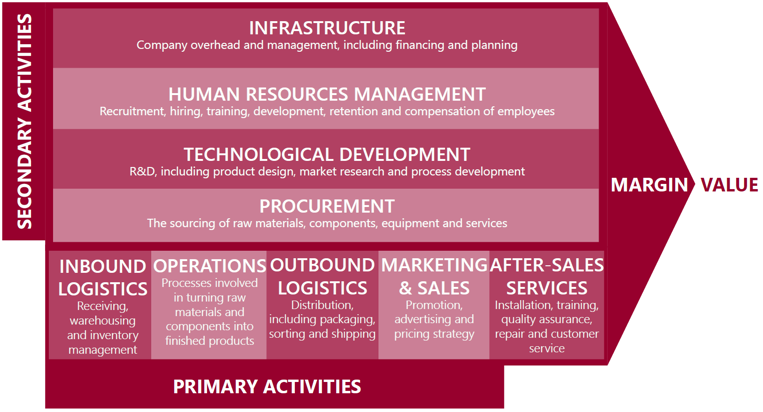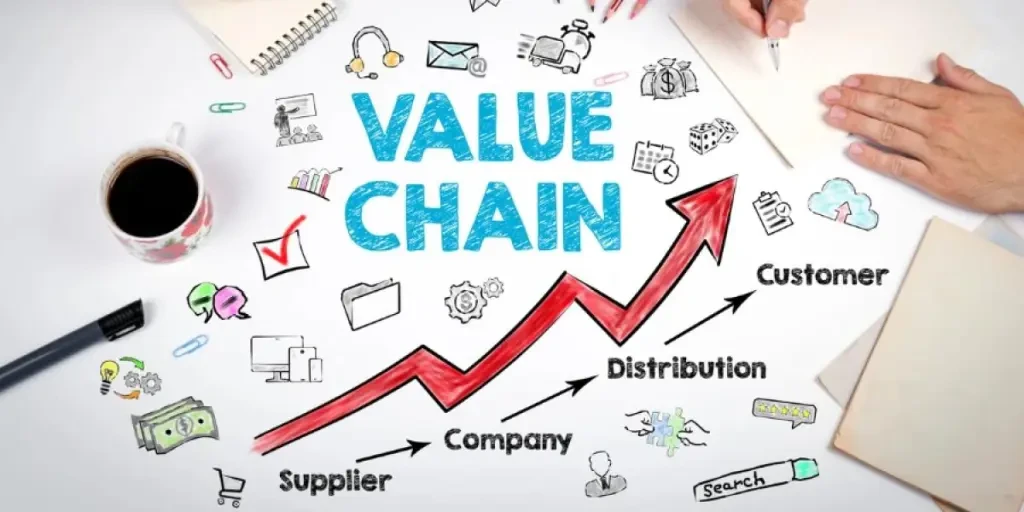Key takeaways
- Value chain analysis helps companies consider how each part of their operations adds or subtracts value from their final product
- Maximising the value at each step of the value chain helps companies enhance customer value and capture market share
- Conducting a value chain analysis is key to identifying areas where you can gain an advantage over your competitors
Value chain refers to the various business processes and activities involved in creating a product or performing a service. A value chain can consist of multiple stages of a product or service’s life cycle, such as sales, research and development, and everything in between.
Value chain analysis is a means of evaluating each of the activities in a company’s value chain to understand where opportunities for improvement lie.
What are the components of a value chain?
So, what actually makes up a value chain?
According to Porter’s Value Chain Analysis definition, all of the activities that make up a firm’s value chain can be split into two categories that contribute to its margin: primary activities and support activities.

Primary activities
Primary activities are those that go directly into the development of a product or the execution of a service. They include:
- Inbound logistics: Activities related to receiving, warehousing and inventory management of source materials and components.
- Operations: Activities related to turning raw materials and components into a finished product.
- Outbound logistics: Activities related to distribution, including packaging, sorting and shipping.
- Marketing and sales: Activities related to the marketing and sale of a product or service, including promotion, advertising and pricing strategy.
- After-sales services: Activities that take place after a sale has been finalised, including installation, training, quality assurance, repair and customer service.
Secondary activities
Secondary activities help primary activities become more efficient, creating a competitive advantage. They include:
- Procurement: Activities related to the sourcing of raw materials, components, equipment and services.
- Technological development: Activities related to research and development, including product design, market research and process development.
- HR management: Activities related to the recruitment, hiring, training, development, retention and compensation of staff.
- Infrastructure: Activities related to the company’s overhead and management, including financing and planning.
What are the different types of value chain?
Value chain activities can be restricted to a company or industry or can be distributed over several locations across the globe. This means that there are three types of value chains.
Company level
The focus in this type of value chain is on business units. It includes all the business activities a firm undertakes to enhance the value of its product and improve its competitive advantage.
Industry level
Industry-level value chains include a broad range of activities involved in making a product, from procurement to final delivery. Analysing this value chain helps to assess possibilities of entry into a new market or expansion into an existing market.
Global level
Under this value chain type, the businesses operating on a global scale carry out activities connected to designing, developing, assembling or marketing at different locations across the globe.
Enhancing competitive advantage
Conducting a value chain analysis prompts you to consider how each aspect of your operations adds or subtracts value from your final product or service. This can help you realise some form of competitive advantage, such as:
- Cost reduction: Making each activity in the value chain more efficient and therefore less expensive.
- Product differentiation: Investing more time and resources into activities like research and development, design or marketing, which can help your product stand out.
How to conduct a value chain analysis
1. Identify value chain activities
The first step in conducting a value chain analysis is to understand all of the primary and secondary activities that go into your product or service’s creation.
2. Determine the cost and value of activities
Once the primary and secondary activities have been identified, the next step is to determine the value that each activity adds to the process, along with the costs involved. The value created by activities is synonymous to customer satisfaction and quality of output.
For instance, does developing a product from high-quality or sustainable materials make it more desirable to end users? Can the addition of a product feature result in higher sales volume?
Similarly, it’s important to understand the costs associated with each step in the process.
3. Identify opportunities for competitive advantage
Once the value chain has been compiled and the cost and value associated with each step has been understood, you can analyse the results to enhance your company’s competitive advantage. For instance, if the primary goal is to reduce costs, each piece of your value chain should be evaluated through the lens of reducing expenses. Similarly, if the primary goal is to achieve product differentiation, it’s important to question which parts of the value chain will better contribute to achieving this goal.
Why is value chain analysis useful?
Analyzing the processes that comprise your company’s value chain can help understand in detail what goes into each of its transactions. By maximising the value created at each point in the chain, your company can be better positioned to enhance customer value while capturing a greater share of the market. Similarly, gaining a deeper understanding of how your firm creates value can enable you to develop a greater understanding of your company’s competitive advantage.
How can value chain analysis be used with other tools?
Value chain analysis can be strengthened by the use of other tools, such as SWOT and PESTLE analysis, and vice versa. Understanding your organisation’s SWOT and PESTLE environment can help you better understand which activities alongside the value chain will yield the most impact if addressed.
For instance, one of the main competitive strengths of operators in the UK Online Flower Retailers industry lies in their ability to develop their website and drive customer traffic to their online channels. Investing in hiring highly skilled web developers and SEO specialists can add to the competitive advantage of a company in this industry. Similarly, internet technology capabilities present a weakness for retail florists that can be tackled through investment in these employees, enhancing their competitive advantage.
You can also use value chain analysis alongside business process analysis, to help improve efficiency in elements of the value chain. Similarly, using industry analysis to assess value chains can be essential to fully understanding your company’s operations.
Digging deeper
Let’s take a closer look at our online flower retailing example. The first step towards conducting a value chain analysis of an online flower retailer would be to understand all of the primary and secondary activities that go into the creation of this service.
Primary activities
- Inbound logistics: Shipping flowers and other flower products from growers to company-owned warehouses.
- Operations: Sorting, packaging and labelling flower products.
- Outbound logistics: Fulfilling the different orders by distributing the flower product directly to consumers with the use of company-owned vans or third-party couriers.
- Marketing and sales: Driving customer traffic to websites, increasing conversion rates, offering discounts, offering subscription services and receiving payment for orders.
- After-sales services: Offering online customer service, generating repeat custom, sending out offers and distributing satisfaction survey to customers.
Secondary activities
- Procurement: Sourcing flower products directly from growers or wholesales, based either domestically or internationally. International suppliers are associated with more intricate primary logistics activities.
- Technological development: Developing brand and product image, front-end and back-end website development and inventory management using barcoding.
- HR management: Recruiting, hiring, training and developing highly skilled employees and outsourcing non-primary activities to contractors.
- Infrastructure: Enhancing operational and supply chain efficiency when it comes to fulfilling flower orders.
Determining the cost and value of activities
The above analysis highlights the importance of technology, HR and logistics operations for online flower retailers. Website development and traffic are essential pillars for a company in this industry to be able to generate revenue. This can’t be achieved without highly skilled tech employees continuously developing, monitoring and enhancing website processes.
Inbound and outbound logistics operations are also paramount to the competitive advantage of online flower retailers. Establishing strong sourcing routes with reputable growers is key to customer satisfaction while having fast and efficient distribution routes can enhance satisfaction and profitability.
Identifying opportunities for competitive advantage
Given the value that logistics, HR and technology add to the competitiveness of online flower retailers, companies can focus on enhancing these activities to add to their competitive advantage. Increasing the speed and minimising the cost of inbound logistics routes can support profitability by raising output. Investing in the efficiency of outbound logistics routes can reduce delivery times and costs, generating an advantage over competitors.
Online flower retailers can also enhance their competitive advantage by hiring highly skilled tech workers that can continuously work on improving website development and conversion rates, allowing for a higher number of orders to be processed.
Final thoughts
Conducting a value chain analysis can be essential in fully understanding how to maximise your company’s potential. By looking at how each part of the supply chain adds and takes away value from your business, it is possible for you to make the changes needed to ensure maximum success for your business, whether this be through improvements to primary activities like logistics and operations, or secondary functions like procurement and technology adoption. A successful value chain analysis will help your company gain a competitive edge and boost performance.
Source from Ibisworld
Disclaimer: The information set forth above is provided by Ibisworld independently of Alibaba.com. Alibaba.com makes no representation and warranties as to the quality and reliability of the seller and products.




